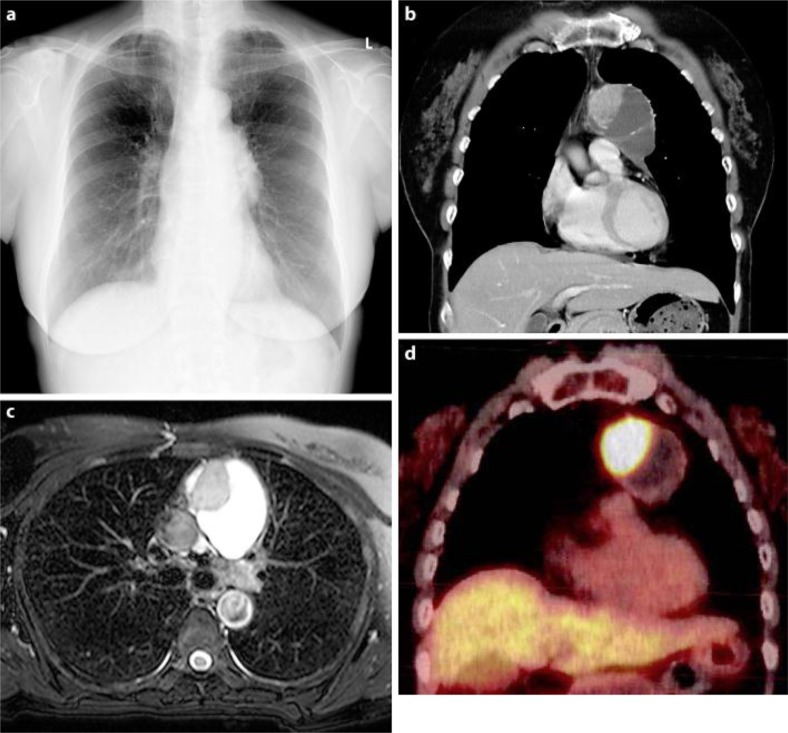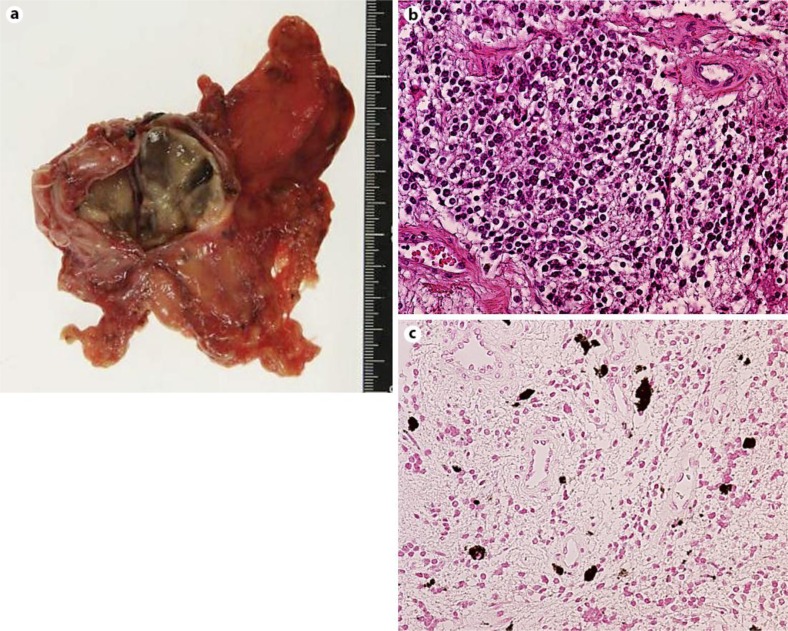Abstract
Case Presentation
A 65-year-old female patient with no clinical manifestations was hospitalized for examination and treatment of an anterior mediastinal tumor found at the time of a regular health checkup. Enhanced computed tomography (CT) and magnetic resonance imaging revealed a cystic lesion containing a solid tumor. Positron emission tomography-CT demonstrated increased uptake in the solid lesion. Tumor resection with total thymectomy was performed. A pathological diagnosis of thymic neuroblastoma within a thymic cyst was made. Micorscopic examination revealed that tumor cells of the solid component were lined with thymic epithelial cells of the inner cyst wall. Furthermore, some tumor cells of the solid component had melanin granules. These findings suggest that this tumor arose from progenitors of the thymic epithelial cells with the potential to differentiate along neural lines.
Conclusions
Neuroblastoma commonly occurs in children. However, the diagnosis of neuroblastoma in adults has been reported in several case reports. We report an adult case of histogenetically informative thymic neuroblastoma within a thymic cyst. There are no standard treatment strategies and chemotherapy protocols. Complete surgical resection might be important for a better outcome.
Key Words: Thymic neuroblastoma, Thymic cyst, Adult
Introduction
Neuroblastoma is one of the most common solid tumors among infants and children. However, the clinical behavior of adult neuroblastoma is reported to be different from childhood neuroblastoma [1]. In addition, thymic neuroblastoma is rather rare [2]. We report a histogenetically informative case of thymic neuroblastoma. This is the first reported case of thymic neuroblastoma within a thymic cyst in an adult.
Case Report
A 65-year-old female patient with no clinical manifestations was admitted to the Department of Thoracic Surgery, Kitano Hospital, for further investigation and treatment of an abnormal chest shadow found at the time of a regular health checkup. Chest X-rays showed a mass lesion with a clear border at the left hilum (fig. 1a). Enhanced chest computed tomography (CT) revealed a 64 × 62 × 34-mm circumscribed anterior mediastinal tumor containing a solid component within a cystic lesion (fig. 1b). T2-weighted magnetic resonance imaging (MRI) also showed a low-intensity area within the high-intensity area corresponding to the cystic lesion (fig. 1c). Furthermore, FDG-positron emission tomography-CT demonstrated increased uptake in the solid lesion (SUVmax 9.9; fig. 1d). Laboratory findings, including tumor markers, such as NSE, proGRP and CEA, were all within the normal range.
Fig. 1.
a Chest X-ray showing a mass lesion with a clear border at the left hilum. b Enhanced chest CT revealing a 64 × 62 × 34-mm-sized anterior mediastinal tumor containing a solid component within a cystic lesion. c T2-weighted MRI showing a low-intensity area within a high-intensity area corresponding to a cystic lesion. d PET-CT demonstrating increased uptake in the solid lesion (SUVmax 9.9).
Based on the diagnosis of thymoma with a thymic cyst, surgical resection was performed for a definitive diagnosis and local treatment. The tumor was located in the left lobe of the thymus. Tumor resection with total thymectomy was performed.
Macroscopically, the chief component of this tumor was a cystic lesion containing yellowish and serous effusion (fig. 2a). In addition, the tumor had a solid component within the cyst. Its cut surface was yellow-gray. Microscopically, the cystic lesion was consistent with a thymic cyst. Furthermore, the solid component was adjacently lined with thymic epithelial cells of the inner cyst wall. The solid component of the tumor had a lobular structure consisting of small uniform cells with round and hyperchromatic nuclei, and an abundant fine eosinophilic matrix consistent with a neuropile (fig. 2b). In addition, some tumor cells had melanin granules (fig. 2c). Immunohistochemical analysis demonstrated that tumor cells in the solid component were positive for neuroendocrine markers such as synaptophysin, chromogranin A and CD56. In contrast, the tumor cells were negative for keratin. Based on the above findings, the final diagnosis was thymic neuroblastoma within a thymic cyst. The clinical stage of the neuroblastoma was Evans stage I.
Fig. 2.
a Solid component within a thymic cyst. b Tumor cells in the solid component representing round and hyperchromatic nuclei and an abundant eosinophilic matrix consistent with a neuropile (H&E stain, ×200). c Some tumor cells had melanin granules (Masson-Fontana stain, ×200).
Although the patient was provided with detailed information about adult neuroblastoma which is associated with a poor prognosis regardless of clinical disease stage, she did not request adjuvant therapy after surgery, and was therefore strictly followed up on an outpatient basis. There was no sign of recurrence or metastasis at 15 months after surgery.
Discussion
Neuroblastoma is a common extracranial solid tumor among infants and children, but it is very rare in adults, and less than 10% of cases occur in patients aged 10 years or older [1]. Furthermore, only a few cases with thymic neuroblastoma have been reported [2, 3]. To our knowledge, this is the first reported case of thymic neuroblastoma within a thymic cyst.
Regarding the histogenesis of thymic neuroblastoma, Argani et al. [2] suggested four possible mechanisms: malignant transformation of mediastinal teratomas, aberrantly located sympathetic ganglia in the thymus, neuroectodermal cells native to the normal thymus, and precursors of thymic epithelial cells with the potential to differentiate along neural lines. In the present case, tumor cells of the neuroblastoma were within the inner cystic wall formed by thymic epithelium. Furthermore, these tumor cells of the neuroblastoma had melanin granules. The thymic epithelium, melanocytes and neuroblastoma cells are all derived from the ectoderm. These findings suggest that this tumor arose from progenitors of the thymic epithelial cells with the potential to differentiate along neural lines.
On the other hand, the biological behavior of adult neuroblastoma is reported to be different from that of childhood neuroblastoma. Franks et al. [1] reported that only 40% of adult neuroblastoma secreted catecholamine metabolites including vanillylmandelic acid and homovanillic acid, which was much lower than the 90% reported in pediatric neuroblastoma [4]. Furthermore, the amplification of the MYCN gene occurs in 20% of childhood neuroblastoma, and it is considered to be associated with tumor aggressiveness [5]. However, the amplification of the MYCN gene was rare in adult neuroblastoma [2]. Unfortunately, these biological markers could not be assessed in the present case because of the preoperative diagnosis of thymoma with a thymic cyst.
Regarding clinical behavior, younger children with stage I, II, and III disease without MYCN amplification had survival rates ranging from 80 to 95%, while adult neuroblastoma has a poorer long-term prognosis regardless of disease stage [1]. Actually, in the present case, PET-CT demonstrated increased uptake in the solid lesion, which suggested the aggressive behavior of the tumor cells. We recommended postoperative adjuvant therapy to the patient because there were several patients who achieved long-term survival after multimodal therapy including chemotherapy and radiation [6, 7]. However, another report revealed that the standard chemotherapy protocols used for childhood neuroblastoma were not effective for adult neuroblastoma [8]. Therefore, case collection and further evaluation with adult neuroblastoma is required [9].
References
- 1.Franks LM, Bollen A, Seeger RC, Stram DO, Matthay KK. Neuroblastoma in adults and adolescents: an indolent course with poor survival. Cancer. 1997;79:2028–2035. doi: 10.1002/(sici)1097-0142(19970515)79:10<2028::aid-cncr26>3.0.co;2-v. [DOI] [PubMed] [Google Scholar]
- 2.Argani P, Erlandson RA, Rosai J. Thymic neuroblastoma in adults: report of three cases with special emphasis on its association with the syndrome of inappropriate secretion of antidiuretic hormone. Am J Clin Pathol. 1997;108:537–543. doi: 10.1093/ajcp/108.5.537. [DOI] [PubMed] [Google Scholar]
- 3.Ogawa F, Amano H, Iyoda A, Satoh Y. Thymic neuroblastoma with the syndrome of inappropriate secretion of antidiuretic hormone. Interact Cardiovasc Thorac Surg. 2009;9:903–905. doi: 10.1510/icvts.2009.210229. [DOI] [PubMed] [Google Scholar]
- 4.Brodeur GM, Castleberry RP. Neuroblastoma. In: Pizzo PA, Poplack DG, editors. Principles and Practice of Pediatric Oncology. 2. Philadelphia: J.B. Lippincott Company; 1993. pp. 739–768. [Google Scholar]
- 5.Seeger RC, Brodeur GM, Sather H, Dalton A, Siegel SE, Wong KY, Hammond D. Association of multiple copies of the N-myc oncogene with rapid progression of neuroblastoma. N Engl J Med. 1985;313:1111–1116. doi: 10.1056/NEJM198510313131802. [DOI] [PubMed] [Google Scholar]
- 6.Shimizu M, Shimizu T, Adachi T, Nishiuchi M, Kanzaki M, Onuki T. Long-term survival in adult mediastinal neuroblastoma. Jpn J Thorac Cardiovasc Surg. 2003;51:326–329. doi: 10.1007/BF02719388. [DOI] [PubMed] [Google Scholar]
- 7.Venat-Bouvet L, Le Brun-Ly V, Martin J, Gasnier O, Falkowsky S, Tubiana-Mathieu N. Long-term survival in adult neuroblastoma with multiple recurrences. Case Rep Oncol. 2010;3:45–48. doi: 10.1159/000286142. [DOI] [PMC free article] [PubMed] [Google Scholar]
- 8.Then C, Ebelt K, Langer A, Mayr D, Schmidmaier R, Oduncu F. Neuroblastoma in a 55-year-old patient: a case report. Case Rep Oncol. 2010;3:458–462. doi: 10.1159/000322863. [DOI] [PMC free article] [PubMed] [Google Scholar]
- 9.Ohtaki Y, Ishii G, Hasegawa T, Nagai K. Adult neuroblastoma arising in the superior mediastinum. Interact Cardiovasc Thorac Surg. 2011;13:220–222. doi: 10.1510/icvts.2010.262204. [DOI] [PubMed] [Google Scholar]




